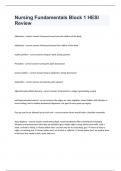Nursing Fundamentals Block 1 HESI Review
Abduction - correct answer Movement away from the midline of the body
Adduction - correct answer Movement toward the midline of the body
supine position - correct answer lying on back, facing upward
Pronation - correct answer turning the palm downward
prone position - correct answer lying on abdomen, facing downward
Supination - correct answer turning the palm upward
Alginate hydrocolloid dressing - correct answer Treatment for a stage 3 granulating wound
well-approximated wound - correct answer the edges are close together, closed (either with stitches or from healing) and in relative anatomical alignment; the goal of every post op surgery
Post op care for pt allowed up to chair only - correct answer Nurse would order a bedside commode
sleep hygiene - correct answer nonpharmacologic recommendations like reviewing and changing lifestyles and environment that help an individual get a better night's sleep; drink warm milk, read a book, no food or fluids 2-4 hours before bed, use bed only for sex and sleep, get 7-9 hours of sleep a night, no working out 2-4 hours before bed, no alcohol or caffeine 2-4 hours before bed, set routine time
to bed and rise, make it dark, quiet and cool Priority treatment of a patient with a serum calcium (Ca) of 7.5 - correct answer Monitor the patient cardiac status and neuromuscular issues (weakness)
Proper Crutches Usage - correct answer Crutches should be 2-3 fingers (1-2 inches) below the axilla between the top of the crutch to prevent risk of brachial nerve damage; the position of the hands on the
hand grips should be with the elbows flexed at a 30 degree angle
The weight bearing should be on the hands and not the axilla
When ambulating stairs with crutches it is up with the good leg and down with the bad leg
Orthostatic (postural) hypotension - correct answer rapid lowering of the blood pressure as a result of changing positions.
how to test for orthostatic hypotension - correct answer Lower bed to supine position and then check BP/HR Laying Flat, BP/HR Sitting Up, BP/HR Standing Up
IT Department (Information Technology) - correct answer Who you call in the hospital when having computer issues and difficulty logging in
Pad the tubing where it contacts the clients ears and cheeks - correct answer What can you do if the skin
breakdown around the cheeks and ears from the oxygen tubing
Non-rebreather mask - correct answer A face mask that is connected to a reservoir bag that is filled with a high concentration of oxygen and delivers at a rate of 70-100% FIO2. Used in emergency respiratory situations. The reservoir bag will NOT completely deflate (this is normal/baseline).
palliative care - correct answer Palliative care is an interdisciplinary medical caregiving approach aimed at optimizing quality of life and mitigating suffering among people with serious, complex, and often terminal illnesses. Supportive medical and nursing care that keeps the patient comfortable but does not cure the disease. hospice care - correct answer A free Medicare program that gives special care to people who are near the end of life (6 months of less) and have stopped treatment to cure their disease. Hospice offers physical, emotional, social, and spiritual support for patients and their families. Caring for the whole person, not just the disease. Addressing your physical, emotional, social, and spiritual needs. Providing the best possible quality of life for whatever time remains. Goal of comfortable, pain free life until death.
intradermal injection/ID - correct answer injections (example: allergy testing, TB, lidocaine) placed just below the epidermis; sites commonly used are the inner surface of the forearm, the dorsal aspect of the upper arm, and the upper back. Use a tuberculin syringe, with a needle length of 1/4 inches to 1/2 inches and a gauge of 25 - 27.
subcutaneous injection (SubQ) - correct answer the administration of medications (example: Heparin, insulin) by injection into the fatty layer just below the skin. The needles are short, at 5/8 inches long. The
thickness of the needle is usually 25 or 27 gauge. Inject at about 45-90 degree angle. (A 25- to 30-gauge, 3/8″ to 1″ needle can be used. The 3/8″ and 5/8″ needles are most commonly used).
intravenous injection (IV) - correct answer the administration of medications (example: antibiotics, chemotherapy, fluids, pain medications) by injection directly into a vein. Always inject towards the patient's heart, in other words in the same direction as the patient's blood flow. Put the needle into the vein at an angle (no more than 45 degrees) with the bevel of the needle facing upwards.
intramuscular injection (IM) - correct answer an injection (example: antibiotics, hormones, vaccines) into
deep muscle tissue, usually of the buttock, thigh, or upper arm. Insert needle at a 90 degree angle to the
skin with a quick thrust. Aspiration is not necessary. Needle size is usually 21 or 23 gauge.
topical medications - correct answer Lotions, creams, and ointments that are applied to the surface of the skin and affect only that area; a medication delivery route.
PO route of administration - correct answer Medications given by mouth
Rule of 15 carb counting - correct answer For low blood sugar between 55-69 mg/dL, raise it by following
the 15-15 rule: have 15 grams of carbs and check your blood sugar after 15 minutes. If it's still below your target range (BS 70), have another serving. Repeat these steps until the blood sugar is 70 or above for 2 readings.




